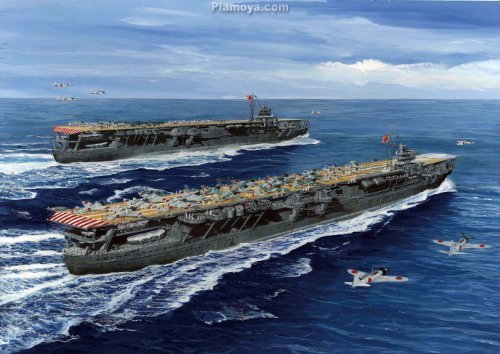
CVs Shokaku & Zuikaku
IJN Shokaku
These two carriers were a substantial enlargement of the successful Hiryu design with greater protection, a more powerful antiaircraft battery, and an expanded air group. They were equipped with two catapults forward, the first aboard Japanese carriers.
Both carriers received substantial additions to their light antiaircraft batteries as the war progressed. Added to them were four triple 25mm mounts when combat damage was repaired in the summer of 1942 and two triple 25 mm plus sixteen single 25mm mounts at the end of the year. The Zuikaku received an additional two triple 25mm and twenty single 25mm weapons when repaired after the Battle of the Philippine Sea, together with six 28- barrelled rocket launchers. Both carriers also received surface and air warning radar sets in late 1943.
The navy began experimenting, initially with the Kaga, the Soryu, and the Hiryu, in early 1941. The first land-based koku kantai, the Eleventh, was formed with three koku sentai in January 1941. In April, the 1st koku kantai brought together the Combined Fleet’s carriers in a single operational units, still organized as three koku sentai. When the new carriers Shokaku and Zuikaku commissioned in the fall of 1941, they replaced the older carriers Hosho and Ryujo, and created the most powerful unified naval air force in the world that became Japan’s principal striking force for the Pacific war it saw looming.
Japanese carrier development during World War II in large part continued the two central themes of prewar design efforts: a search for both qualitative excellence in individual vessels and for quantitative equality or superiority relative to the United States Navy. The search for qualitative excellence was demonstrated by the Taiho, which combined the performance and aircraft capacity of the Shokaku class (the epitome of Japanese prewar design) with greatly enhanced protection, while the demand for quantity production was exemplified by the Unryu class and the Imperial Japanese Navy’s very extensive “shadow” carrier fleet. The limitations of Japan’s industrial base made this an impossible task. Most of the “shadow” carrier designs required major qualitative concessions of speed, aircraft capacity, or protection that limited their contribution to carrier task force capabilities, the Unryu class represented a step back in Japanese carrier quality, and the Imperial Japanese Navy abandoned its hopes of producing further carriers of the Taiho’s excellence.
The elevators were much larger than in the earlier pair of ships. The Shokaku and the Zuikaku were unique among Japanese carriers in carrying a pair of catapults, derived from units developed for use on the Yamato-class battleships, on the flight deck. As originally designed the two ships were to have islands on opposite sides, one to starboard and the other to port, as with earlier pairs of vessels operating in koku-sentai formation. By the time construction reached the point of fitting islands the disadvantages of the port side island amidships had made themselves apparent, so both vessels received islands forward of amidships on the starboard side.
Shōkaku-class aircraft carrier
| Class overview | |
|---|---|
| Name: | Shōkaku class |
| Builders: | Kawasaki Kobe Shipyard Yokosuka Naval Arsenal |
| Operators: | Imperial Japanese Navy |
| Preceded by: | Hiryū |
| Succeeded by: | Taihō |
| Built: | 1938–1941 |
| In commission: | 1941–1944 |
| Completed: | 2 |
| Lost: | 2 |
| General charactes-tics (as built) | |
| Type: | Aircraft carrier |
| Displacement: | 32,105 t (31,598 long tons) (deep load) |
| Length: | 257.5 m (844 ft 10 in) |
| Beam: | 29 m (95 ft 2 in) |
| Draft: | 9.32 m (30 ft 7 in) (deep load) |
| Depth: | 23 m (75 ft 6 in) |
| Installed power: | 160,000 shp (120,000 kW) 8 × water-tube boilers |
| Propulsion: | 4 × shafts; 4 × Kampon geared steam turbines |
| Speed: | 34.5 knots (63.9 km/h; 39.7 mph) |
| Range: | 9,700 nmi (18,000 km; 11,200 mi) at 18 knots (33 km/h; 21 mph) |
| Complement: | 1660 officers and crewmen |
| Armament: | 8 × twin 127 mm (5 in) Type 89 dual-purpose guns 12 × triple 25 mm (1 in) Type 96 AA guns |
| Armor: | Waterline belt: 46–165 mm (1.8–6.5 in) Deck: 65–132 mm (2.6–5.2 in) |
| Aircraft carried: | 72 (+12 spares) 7 December 1941: 18 × Mitsubishi A6M Zeros 27 Aichi D3A “Val”s 27 Nakajima B5N “Kate”s |